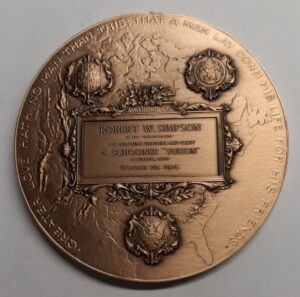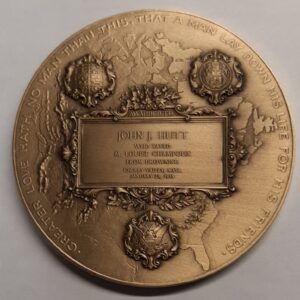Every year, the Carnegie Hero Fund Commission distributes individually-struck, bronze medals to award recipients or their families, with the hope that they will serve as a lasting reminder of the hero’s legacy — passed down generations as a cherished heirloom. Sometimes, however, medals find their way back to us.
A new column in Impulse will include telling the stories of the heroic deeds that resulted in the awarding of the Carnegie Medal that are displayed in the Hero Fund’s offices in Pittsburgh. This quarter two bronze medals found their way to the Commission: a 1906 medal awarded to Robert W. Simpson and a 1916 medal awarded to John J. Hutt. They were sent to our refinisher for a shine and will be displayed among others in the Commission’s gallery.
Robert W. Simpson

Although the Commission doesn’t seek to collect Carnegie Medals being sold, occasionally staff members come across a Carnegie Medal that needs a home. And no better second home than the Commission’s offices — apart from the safe haven of the recipient’s family. The Commission won the Simpson medal with the highest bid from a Stack’s Bowers Auction.
Simpson was awarded the medal for his part of a four-man crew that braved a horrific storm on Lake Erie to rescue six men on Oct. 20, 1905.
The six men were stranded on a sinking schooner about a mile from Ashtabula Harbor, Ohio. The schooner “Yukon” was separated from a steamer that was towing it and it “lay helpless” in the “heaviest gale ever experienced on Lake Erie” at the time, according to the Commission’s 1906 meeting minutes.
The wind was blowing at 58 m.p.h., and waves were 14 feet high.
The crew of another ship, the 73-foot-tug “Thomas Wilson,” left the safety of the harbor to rescue the men. On that boat was Captain Timothy E. Heagerty, 41; Steamboat Engineer Simpson, 46; Steamboat Fireman Michael Sasso, 22; and sailor Jeremiah M. Donovan, 26.
“Life boats could not be used in taking the men from the schooner to the tug, and it was necessary to steer the tug close enough to the Yukon to enable the men to jump from one boat to the other,” the report stated.
Twice, Captain Heagerty maneuvered his large tug to the schooner with success, but on the last attempt, the boats collided, destroying a portion of the Robert Wilson’s gunwales. Despite the collision, all six men aboard the Yukon made it to safety.
“Captain Heagerty is regarded as one of the best navigators of the Lakes,” the report stated.
According to Hero Fund records, Simpson “very faithfully performed his duties at the engine, and shared the common peril with the captain and other crew.”
Supporting a wife and 10-year-old child on a $50 monthly salary, the Commission awarded Simpson a bronze Carnegie Medal and $1,450.
John J. Hutt

The Carnegie Medal of John J. Hutt was donated to the Commission after a relative found the medal among his deceased mother-in-law’s possessions.
“None of her surviving relatives is aware of any connection to John, and we have no idea how she acquired it,” wrote Joe Trojanowski in an e-mail to the Hero Fund.
It was early evening Jan. 21, 1915, when 9-year-old M. Louise Champoux broke through the ice covering a Cherry Valley, Massachusetts, pond, about 250 feet in diameter. She screamed, which caught the attention of Hutt, 42, a father of three young children, and his wife, 38.
As she struggled to remain afloat in water 12 feet deep, Hutt crawled on and slid over the ice on his stomach toward Louise, who submerged and was carried by a 4 m.p.h. current under the ice, resurfacing in another area of open water. Just about as Hutt reached Louise, the ice broke under him as well.
The Hero Fund’s report states that Hutt felt the bottom of the pond — which was about a foot of mud. He resurfaced, but could not see Louise. He held his breath and dove under the surface of the water, groping for the girl.
Finding her at the bottom, he lifted her to the surface and onto the ice. As he started to climb out of the water onto the ice, it broke again, returning both of them to the water. Hutt grasped Louise, who was then unconscious, again and pushed her ahead of him as he broke a path through the ice. Eventually he was able to push her onto solid ice and climb up himself. He carried her to the bank where others tended to her. She was revived.
Hutt suffered a heavy cold, but he recovered.
Hutt told Hero Fund Special Agent John Benitz at the time that while he did not think he was risking his life at the time of the rescue, “after it was completed, he realized what he had done and thought he had risked his life,” risking frigid water temperature, being heavily dressed and sticking to the bottom of the lake in the mud, or getting carried under the ice.
Hutt was awarded the bronze medal and $1,000.

